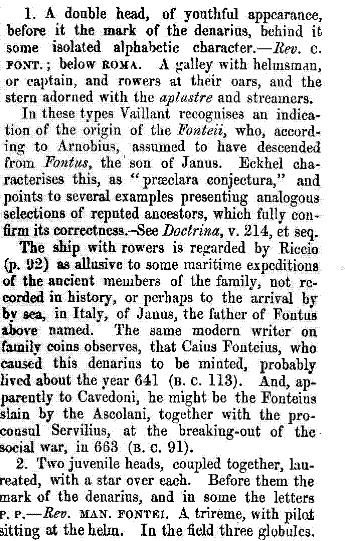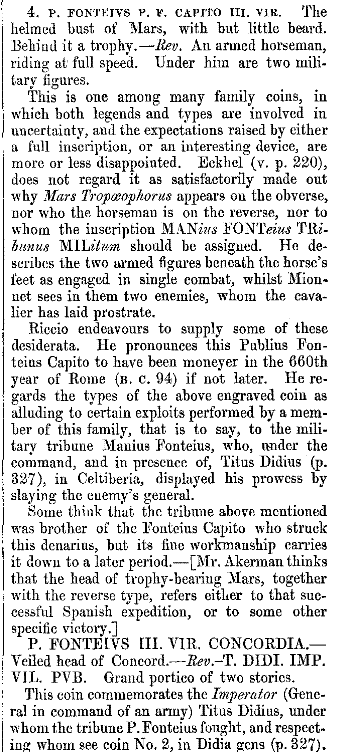









Fonteia gens, of the highest antiquity; but plebian, for Clodius caused himself to be adopted by P. Fonteius, in order that he might be a tribune of the plebs. The surname is Capito. There are nine disrinct mintages in its coins, besides a great many minor varieties. The silver are, with few exceptions, common. The brass pieces are the As, or its parts, struck by the moneyers of Mark Antony.

The following are amongst the most rare or curious denarii of this family:
1. A double head of youthful appearance, before it the mark of the denarius, behind it some isolated alphabetic character. Reverse: C FONT; below ROMA, a galley with helmsman or captain, and rowers at their oars, and the stern adorned with the aplustre and streamers.
In these types Vaillant recognises an indication of the origin of the fonteii, who, according to Arnobius, asumed to have descended from Fontus the son of Janus. Eckhel characterises this as "praeclara conjectura," and points to several examples presenting analogous selections of reputed ancestors, which fully confirms its correctness. See Doctrina, |v| 214, et seq.
The ship with rowers is regarded by Riccio (p 92) as allusive to some maritime expiditions of the ancient members of the family, not recorded in history, or perhaps the arrival by sea of Janus to Italy, the father of the Fontus above named. The same modern writer on family coins observes that Caius Fonteius, who caused this denarius to be minted, probably lived about the year 113 BC. And, accoding to Cavedoni, he might be the same Fonteius slain by the Ascolani, together with the proconsul Servilius at the breaking out of the social war in 91 BC.
2. Two laureate juvenile heads coupled together, with a star over each. Before them the mark of the denarius, and in some the letters P P. Reverse: MAN FONTEI, a trireme with pilot sitting at the helm. In the field three globules.

The two heads on the obverse are those of the Dioscuri, who are the Panates of the capital. On a specimen of the above denarius, engraved by Riccio (Tav. 20, No. 2), the letters P P apear before the heads. This is made still more clear in similar types of the Antia and Sulpicia families. For some explanatory remarks on these domestic deities, the reader is referred to the word Penates. "The mint of Fonteius (says Eckhel) adopts these types, because, as we learn in the case of the Sulpicia family, the Penates were held in the highest honour at Tusculum, from which town the Fonteii originally came," See Doct. Num. |v| 218
Cavedoni (cited by Riccio p 93), says that the Manius Fonteius of the silver coins and also of large brass, classed with the mintages of the Fonteia gens, must be the same person who was defended by Cicero; since, in the newly discovered fragment of the oration delivered by him, M. Fonteius is expressly mentioned as his monetal triumvir and his questor. He was pretor in 79 BC and thence it is to be inferred that a little while before he was moneyer.

3. M. FONTEI C. F., the head of a young man laureated, beneath which is the fulmen. -- Reverse: a winged boy riding on a goat. In the field of the coin are two pilei with a star over each. Below is the thyrsus. All within a myrtle garland.
The portrait on the obverse of this denarius is, in the opinion of Eckhel himself, not incorrectly believed to be that of Apollo Vejovis, to whom the thunderbolt under the head bears allusion. As to the winged boy sitting on a goat, Eckhel says that it seems to be rather the "Genius of Vejovis," than, as to others it has appeared the fugure of Cupid, in which opinion (says he), I follow Passeri, who regards such figures of winged children, except when they hold a bow or an arrow, as genii. The hats of the Dioscuri belong to the Dei Penates. As to why the thyrsus and myrtle crown form |part| of the type, and also as to who was Manius Fonteius, the author of these denarii, the numismatist of Vienna, with his usual repudiation of conjecture, simply adds "ignoro."
Riccio, in desribing the above denarius, says "This Manius Fonteius must have been moneyer about 84 BC, and son of that |Caius| Fonteius, who was legatus to Manius Fonteius, pretor in Gaul, posterior to 79 BC, and reckoned among the primarii viri by Cicero.
Cavedoni believes the infant figure on the goat to be meant for the genius of Jupiter Crescens, seated on the back of his own goat [Amalthaea], and is of opinion that the reiterated appearance of caps of the Dioscuri bears allusion to the original country of the monetal functionary who caused the coin to be struck.

4. P FONTEIVS P F CAPITO III VIR, the helmeted bust of Mars with a short beard; behind a trophy. Reverse: an armed horseman riding at full speed; under are two military figures.
This is one among many family coins in which both legends and type are involved in uncertainty, and the expectations raised by either a full legend or an interesting type are more or less disappointed.
................
P FONTEIVS III VIR CONCORDIA, veiled head of Concord. Reverse: T DIDI IMP VIL PVB, grand portico of two stories.
This coin commemorates the Imperator (general in comand of an army) |Titus| Didius, under whom the tribune P. Fonteius fought, and respecting whom see coin No. 2 in Didia gens.